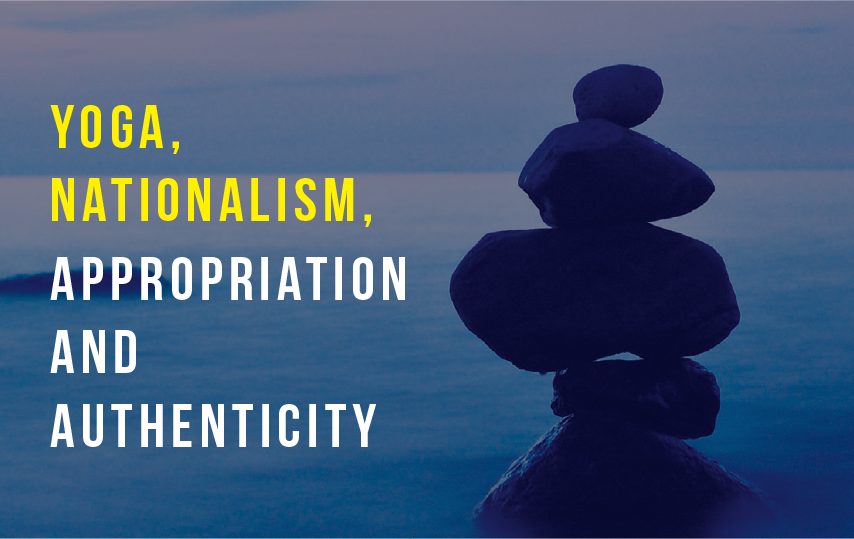Yoga is a household word in America, with tens of millions swearing by its many benefits. This ancient practice has spawned a multi-billion dollar industry, numerous affiliated brands, franchises, and thousands of slick studios and retail outlets scattered across the country.
According to the latest Yoga Journal survey, Americans – mostly white, upper middle class and overwhelmingly female – spend close to $17 billion per year on yoga classes, ‘teacher training’ courses, accessories and related products.
As anyone with their critical faculties intact could see, ‘Yoga’ had devolved into just another marketing meme deployed to fill the coffers of large corporations and was increasingly losing sight of its roots.
Case in point, Leslie Kaminoff, a New York based yoga instructor, advocates a version of yoga that is entirely stripped of cultural, ontological or historical context.
In his words: “I wouldn’t even say that yoga as a field necessarily needs to gain its authenticity from this feeling that it was invented by Indians. I mean, there’s a difference between mechanical bull for sale inventing something and discovering it. I believe of course, that yoga was discovered in India; but that doesn’t mean that Indians own it.”
He even admits that “the world has turned into a place where someone like me – who is profoundly unemployable in any other field – can travel the globe sharing these teachings with the sincere, dedicated groups of lifelong learners we call Yoga Educators”.
Dr. Jeffery Long, a religious studies scholar, observes “the reasoning on display here seems to be based on sweeping and not altogether accurate generalizations about the history of yoga. The argument is not that non-Indians should not be practicing yoga. The argument is that the practice has been so utterly distorted and decontextualized as to barely merit being called ‘yoga. The argument is that what is happening in many (though not all) cases in the west is, in effect, false advertising.”
And it’s not just Americans cashing in on the yoga craze: Indian guru Ramdev has no qualms using the legendary author of the Yoga Sutras to market his ‘Patanjali Noodles’ and ‘Patanjali Jeans’.
Kaminoff makes no bones about his affiliations with the far right of the political spectrum. He loudly proclaims that racism, colonialism and white privilege are “illusions of the collective” with no basis in reality.
A direct line can be drawn between Kaminoff’s political philosophy and his exploitative attitude toward yoga. In his own words, “I have been contemplating and applying Ayn Rand’s ideas in every area of my life and career for four decades, and I’m well aware of the hard work it’s taken to forge a consistent world view in which the principles of Yoga are compatible with those of Objectivism. It wasn’t easy, but I did it, and I owe whatever success I’ve had in my life to the effort I put in.”
Hard indeed: a philosophy that teaches the overcoming of ego and one that teaches that there is nothing of greater value in this world than the pursuit of one’s own egoistic desires.
The hyper-capitalist ideology that Kaminoff represents nixes any chance for concerted action to protect the vulnerable, the underserved, the environment or the elderly. It’s each man or woman for him- or herself. Whoever climbs to the top of the ladder has proved their “greatness.” All the rest of the losers are left to wallow in their mediocrity.
Yet another self-proclaimed ‘ayurvedic consultant’ from Canada, Matthew Remski, blithely appropriates and repackages texts like the Bhagwad Gita, and is paid to deliver presentations to bright eyed neophytes at yoga studios, posturing as an authority in the area. Like many who peddle their wares via their social media accounts and depend on the spiritual supermarket for their livelihood, Remski and Kaminoff do not possess any formal degrees in Sanskrit, Ayurveda or Indology, yet take frequent liberties with the core tenets, mangling and distorting them in the process. Indeed, Yoga is perhaps the only profession in the west where one can hold forth as an authority on a vast array of subjects without putting in the requisite time to acquire hard credentials in them.
As a commenter on popular site Yogadork pithily remarked, ‘the confluence of the unregulated yoga marketplace and the Internet have allowed them to make a living bamboozling the gullible yoga crowd. Absent yoga, they’d be lucky to be flipping burgers at Mickey D’s” – –
The above are classic examples of cultural appropriation, which essentially refers to a member of one culture borrowing elements of another culture and repurposing them in a way that to some degree distorts their meaning—often in a way that indicates that the appropriator is ignorant of, or insensitive to, the meaning of those cultural elements in their original context.
Conversely it could be said that charges of cultural appropriation ignore the agency of Indians themselves, who have been making a concerted effort to export yoga to the West since the late 19th century. The Hindu monk Swami Vivekananda, who introduced yoga philosophy to America in the 1890s, wrote to a journalist friend, “By preaching the profound secrets of the Vedanta religion in the Western world, we shall attract the sympathy and regard of these mighty nations, maintaining for ever the position of their teacher in spiritual matters, and they will remain our teachers in all material concerns.”
Enthusiastic as he may have been about the globalization of Indian spiritual practices, Vivekananda would certainly not agree that the Yoga Sutras were an artifact of a bygone era, irrelevant in the 21st century, as some sections of the American yoga community would have us believe.
Apart from entitled white men and women, Yoga is also claimed by Hindu nationalists, whose idea of India is one in which minorities–especially Muslims–are painted as villains and Hindus as the eternal victims. They are prone to seeing the world in simple binaries and are constantly engaged in a Manichaean struggle between the forces of ‘Dharma’ (i.e. neo-Hindu zealots) and anti-Dharma (i.e. seculars, academia, Islam, the West). Many of them can be observed on social media trolling western yoga teachers for appropriation and commodification of their sacred traditions. While the charges may be valid in some cases, it is only too easy to dismiss them as the ravings of religious nutjobs. A growing number jumpers for sale of ‘white hindus’ influenced by Hindu supremacist rhetoric will often join their Indian counterparts in the online troll wars to ‘take back yoga’, the hilarious irony apparently lost on them.
Debashish Banerji , professor of religious studies at California Institute of Integral Studies says, “Due to the proliferation of western educational models and the assimilation of postcolonial populations under global capitalism, the majority of middle class India lacks a foundation in its traditional scholarship, yet seeks the psychological security of a national identity. Yoga is touted by the Hindu right as just this badge of national identity; so that an enormous section of the majoritarian population unthinkingly embraces its chauvinistic identity politics, a most dangerous development.”
Genuine Sadhakas, serious spiritual practitioners, have to negotiate and refine their personal truth every day, navigating the tricky terrain of yoga politics and the vested interests lying in ambush. The practice of yoga compels us to bring our attention to the present moment, through a union of breath, movement and gaze. This is perhaps the simplest way of expressing “Chitta Vritti Nirodha,” the stated goal in the Yoga Sutras and numerous texts on Buddhist meditation. The popular catch phrase “mindfulness” means no more than facilitating the Witness state, unruffled by thoughts, projections, memories, and sensations: i.e. “Vrittis.” Viewing it through an ideological or sectarian filter as the sole property of Hindus, using it as a cash cow, reducing it to physical fitness, or stripping it of essence and then milking it for maximum profit, are detrimental to abiding in the state of Yoga.
In the context of the American, and increasingly the urban Indian marketplace, the word “yoga” is clearly molded to the demands of the paying customer, to whom cosmetic notions of physical beauty and “feeling good” are paramount. The real work of yoga, stripping away of masks and false accouterments gathered over years and just sitting in one place with all our uncertainty and imperfections, cannot be monetized and is anti-capitalist to the core. It is also anti-ideology and anti-dogmatic, whether that dogma be religious or materialist in nature.
Both Western appropriations of Yoga and Hindu nationalist attempts to “take it back” are therefore not only destructive and ultimately oppressive. They are, ironically, inimical to the aims of the very practice that they each claim to advance: one through the lens of capitalist, materialist body worship, the other through the lens of cultural and ethnic chauvinism. Maybe no one “owns” Yoga. But what are the costs of denying its roots in Indian traditions and cultures? I submit that these costs are great indeed: too great to accept.
To read the full article please download our Asana Journal App or purchase Issue 166 October 2016.




















 Other
Other